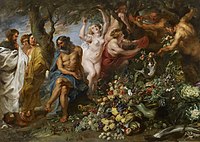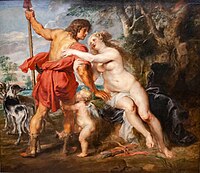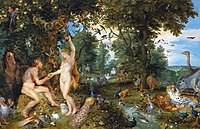পিটাৰ পল ৰুবেন্স
অৱয়ব
| পিটাৰ পল ৰুবেন্স | |
|---|---|
 স্ব-প্ৰতিকৃতি, ১৬২৩, ৰাজকীয় সংগ্ৰহশালা | |
| জন্ম | ২৮ জুন, ১৫৭৭ জিগান, নাসাউ-ডিলিনবাৰ্গ, পবিত্ৰ ৰোম সাম্ৰাজ্য |
| মৃত্যু | ৩০ মে', ১৬৪০ (৬২ বছৰ) এণ্টৱাৰ্প, স্পেনীয় নেদাৰলেণ্ড |
| জীৱন-সংগী | ইছাবেলা ব্ৰাণ্ট (বি. ১৬০৯; মৃ. ১৬২৬) হেলেনা ফোৰমেণ্ট (বি. ১৬৩০) |
| দেশ | ফ্লেমিশ |
| পেচা | চিত্ৰাঙ্কন, ৰেখাঙ্কন, তাপিশ্ৰী, প্ৰিণ্টৰ নক্সা |
| প্ৰশিক্ষণ | টোবায়াছ ভেৰহেক্ট আডাম ফন নুৰ্ট অটো ফন ভিন |
| বিপ্লৱ | ফ্লেমিশ বাৰোক |

ছাৰ পিটাৰ পল ৰুবেন্স (ইংৰাজী: Peter Paul Rubens/ ˈ r uː b ən z / ROO -bənz; [1] ডাচ: ˈpeːtər pʌul ˈrybəns; ২৮ জুন ১৫৭৭ – ৩০ মে' ১৬৪০) এজন ফ্লেমিছ শিল্পী আৰু কূটনীতিবিদ আছিল।[2] তেওঁক ফ্লেমিছ বেৰক পৰম্পৰাৰ আটাইতকৈ প্ৰভাৱশালী শিল্পী হিচাপে গণ্য কৰা হয়। ৰুবেন্সৰ অতি উচ্চ পৰ্যায়ৰ ৰচনাসমূহে ধ্ৰুপদী আৰু খ্ৰীষ্টান ইতিহাসৰ পাণ্ডিত্যপূৰ্ণ দিশসমূহৰ উল্লেখ কৰে। তেওঁৰ অনন্য আৰু অতি জনপ্ৰিয় বেৰক শৈলীত গতি, ৰং আৰু কামুকতাক গুৰুত্ব দিয়া হৈছিল, যিয়ে প্ৰতিসংস্কাৰত প্ৰচাৰিত তাৎক্ষণিক, নাটকীয় কলাত্মক শৈলী অনুসৰণ কৰিছিল। ৰুবেন্স আছিল এজন চিত্ৰশিল্পী যিয়ে পৌৰাণিক আৰু ৰূপক বিষয়ৰ বেদী, প্ৰতিকৃতি, প্ৰাকৃতিক দৃশ্য আৰু ইতিহাস চিত্ৰ নিৰ্মাণ কৰিছিল। তেওঁ ফ্লেমিছ টেপেষ্ট্ৰী কৰ্মশালাৰ বাবে কাৰ্টুন আৰু এণ্টৱাৰ্পৰ প্ৰকাশকসকলৰ বাবে ফ্ৰণ্টস্পিচৰ ডিজাইনাৰ আছিল।
চিত্ৰ
[সম্পাদনা কৰক]



- প্ৰাথমিক চিত্ৰকলা
-
Equestrian Portrait of the Duke of Lerma, 1603, Prado
-
Portrait of Marchesa Brigida Spinola-Doria, 1603, Prado Museum
-
The Judgement of Paris, প্ৰায় 1606, Museo del Prado
-
Venus at the Mirror, 1613–14
-
Diana Returning from the Hunt, 1615, oil on canvas, Gemäldegalerie Alte Meister
-
The Rape of the Daughters of Leucippus, প্ৰায় 1617, oil on canvas, Alte Pinakothek
- Portraits
-
Child with a bird, 1614 and 1625, Gemäldegalerie, Berlin
-
Portrait of King Philip IV of Spain, প্ৰায় 1628–29
-
Portrait of Ambrogio Spinola, প্ৰায় 1627, National Gallery in Prague
-
Portrait of George Villiers, 1st Duke of Buckingham, প্ৰায় 1617–1628, Pollok House
-
Lady Arundel with her Train, 1620
-
Portrait of a Man as Mars, 1620–1625, private collection
- Landscapes
-
Landscape with the Ruins of Mount Palatine in Rome, 1615
-
Miracle of Saint Hubert, painted together with Jan Bruegel, 1617
-
Landscape with Milkmaids and Cattle, 1618
-
The Dance of the Villagers, Prado, c. 1635
-
A View of Het Steen in the Early Morning, প্ৰায় 1635–1638, National Gallery, London
-
Feasting and dancing peasants, Louvre, c. 1636
- Mythological
-
Venus, Cupid, Bacchus and Ceres, 1612
-
Jupiter and Callisto, 1613, Museumslandschaft of Hesse in Kassel
-
Pythagoras Advocating Vegetarianism, 1618–1630, by Rubens and Frans Snyders, inspired by Pythagoras's speech in Ovid's Metamorphoses, Royal Collection
-
Perseus and Andromeda, প্ৰায় 1622, Hermitage Museum, Saint Petersburg
-
Ermit and sleeping Angelica, 1628
-
Perseus Liberating Andromeda, 1639–40, Museo del Prado
-
Minerva Protecting Peace from Mars, 1629–1630, The National Gallery, London
-
The Three Graces, 1635, Prado
-
Diana and her Nymphs surprised by the Fauns, প্ৰায় 1639–40, Prado Museum
-
Venus and Adonis, 1635–1638, Metropolitan Museum of Art
-
King Ixion fooled by Juno, whom he wanted to seduce Louvre Museum)
-
The Birth of the Milky Way, প্ৰায় 1637, Prado Museum
- Helena Fourment and related pictures
-
Rubens with Helena Fourment and their Son Peter Paul, 1639, Metropolitan Museum of Art
-
Helena Fourment in Wedding Dress, প্ৰায় 1630, Alte Pinakothek
-
Helena Fourment in a Fur Wrap, also known as Het Pelsken, 1636–1638, Kunsthistorisches Museum
-
Bathsheba at the Fountain, c. 1635, Gemäldegalerie Alte Meister, Dresden
-
Pastoral Scene, c. 1637, Hermitage Museum
-
The Birth of the Milky Way,Museo del Prado 1636,
- Biblical Scenes
-
Susanna and the Elders, 1609–1610, Real Academia de Bellas Artes de San Fernando
-
Jan Brueghel the Elder and Peter Paul Rubens, The Garden of Eden with the Fall of Man, Mauritshuis, The Hague
-
Lot and His Daughters, প্ৰায় 1613–14
-
The Holy Trinity, Kunstmuseum Basel
-
Christ Triumphant over Sin and Death, Musée des Beaux-Arts de Strasbourg
-
The Annunciation, 1609, Kunsthistorisches Museum
- Drawings
-
The Night, 1601–1603, black chalk and gouache on paper (after Michelangelo), Louvre-Lens
-
The Farnese bull, 1600–1608, British Museum
-
Man in Korean Costume, প্ৰায় 1617, black chalk with touches of red chalk, J. Paul Getty Museum
-
Robin, the Dwarf of the Earl of Arundel, 1620, pen and brown ink over red, black and white chalk, Nationalmuseum
-
Possibly Rubens' daughter Clara Serena, প্ৰায় 1623, Albertina
-
Young Woman with Folded Hands, প্ৰায় 1629–30, red and black chalk, heightened with white, Boijmans Van Beuningen
তথ্যসূত্ৰ
[সম্পাদনা কৰক]- ↑ "Rubens". Random House Webster's Unabridged Dictionary.
- ↑ Weststeijn, T. (2008). The Visible world: Samuel van Hoogstraten's art theory and the legitimation of painting in the Dutch Golden Age. Amsterdam University Press. আই.এচ.বি.এন. 978 90 8964 027 7.















































